Journey times in the Scottish Criminal Justice System: April 2022 to December 2022
This bulletin assesses an accused person’s criminal justice journey time from offence date to case conclusion or verdict for the period from April 2022 to December 2022. It analyses the average length of journey and how these journey times have been impacted by the COVID pandemic.
This document is part of a collection
7. Accused that proceed to court
7.1. Time from offence to verdict
When the procurator fiscal decides to raise court proceedings against the accused then the accused will be registered in court. This may result in a summary prosecution (in Sheriff or Justice of the Peace (JP) court) or a solemn proceeding (in either Sheriff court or High court).
When an accused is registered in court, several outcomes can occur:
- the accused is convicted, either after pleading guilty or being found guilty after evidence has been heard in Court,
- an acceptable plea short of plea of guilty as libelled is accepted (partial plea),
- the accused is acquitted following a not guilty or a not proven verdict,
- the accused has their plea of not guilty accepted by the prosecutor, or
- the case against an accused is deserted i.e. the Crown decides to not proceed with a prosecution at that time (though they may in some cases decide to prosecute at a future date).
Those convicted of a crime or offence in court can be admonished, given an 'other' disposal, a fine, a community disposal, or a custodial sentence. More information on these criminal proceedings can be found here:
Criminal Proceedings in Scotland statistics - gov.scot (www.gov.scot)
The analysis shows that overall, during the pre-COVID period (before 2020-21), 84% of the accused proceeded against in criminal courts had a disposal issued within one year of the offence being committed and 97% within 2 years. However, since the beginning of the COVID-19 pandemic these percentages have decreased to 61% and 89%, respectively (Figure 3).
Over the entire period covered by this data set, fewer than 0.9% of accused waited more than 5 years for a disposal.
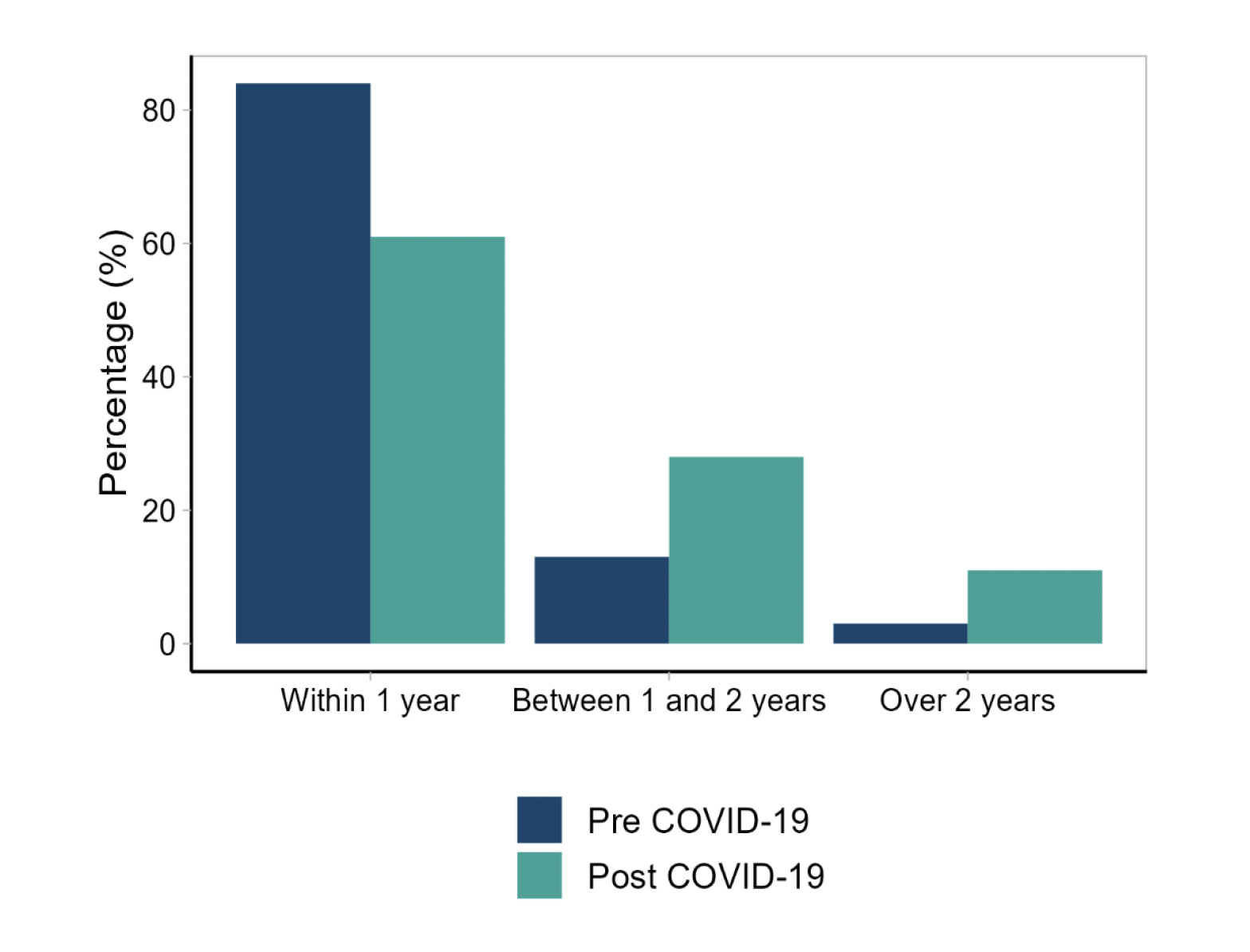
7.2. Time from offence to verdict by type of court
Figure 4 (and supplementary table 2) shows the median journey time by court type for each financial year. Median journey times increased in all court types in 2021-22 when compared to 2019-20: 71% for High Court (from 528 to 900 days), 55% for Sheriff solemn (from 282 to 436 days), 141% for Sheriff summary (from 124 to 299 days) and 82% for Justice of the Peace (from 177 to 322 days).
With the exception of JP courts, all court types have seen an additional increase in journey times over the 9 months of 2022-23 covered in the analysis. High court journey times have increased by an additional 156 days to 1,056 days (17%), Sheriff solemn by 74 days to 510 days (17%), Sheriff summary by 25 days to 324 days (8%). Over the same period, journey times in JP court have decreased by 6% or 18 days to 304 days.
Figure 4: Median time from offence to verdict by type of court.
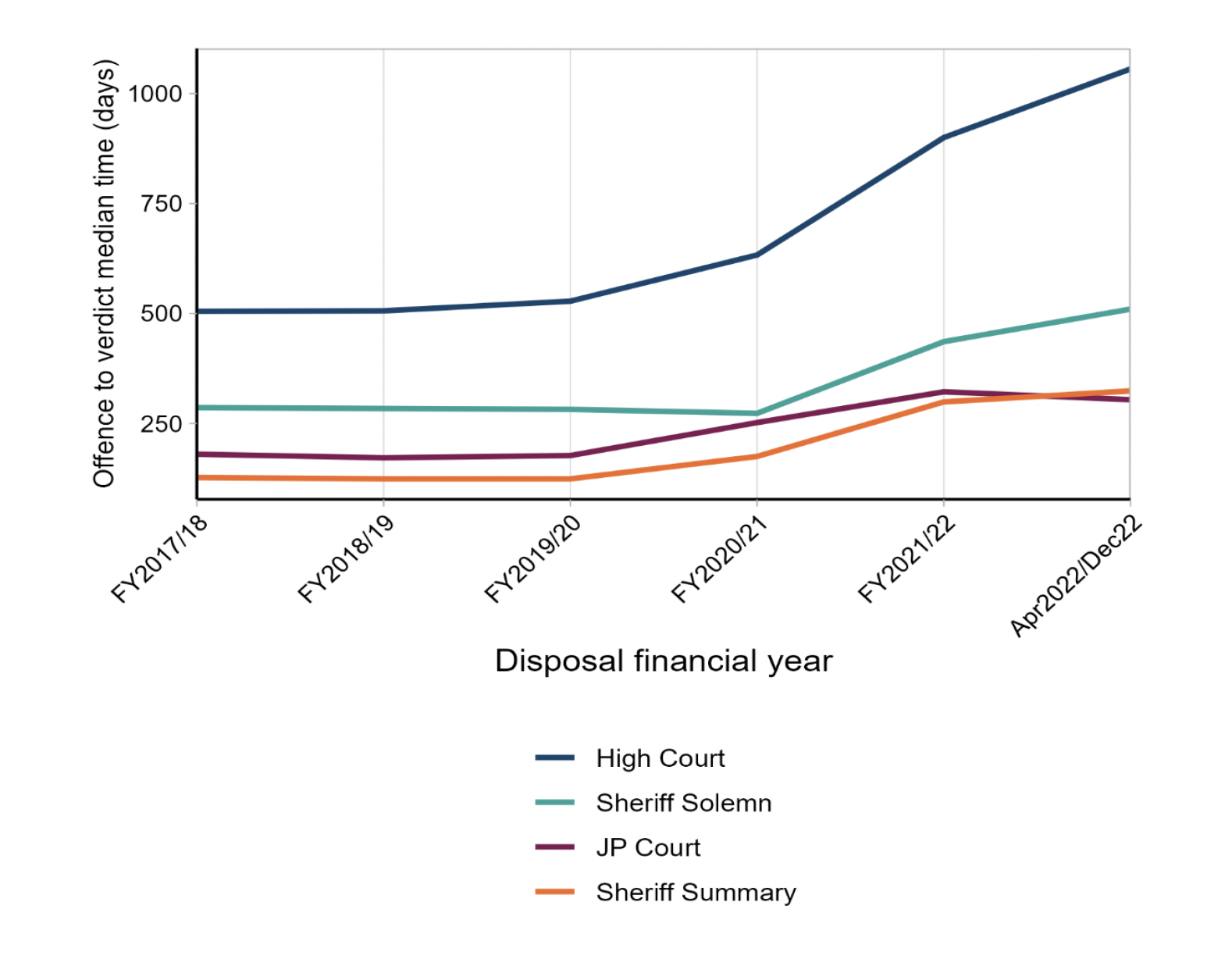
7.3. Time from offence to verdict by warrant status
The median court journey times described above include all accused that have been prosecuted in criminal courts. However, if the accused fails to appear, the court may issue an arrest warrant, which can lead to an increase in the time taken to issue a verdict. Figure 5 (and supplementary table 3) shows median journey times broken down by type of court and warrant status, that is if the accused had ever had a non-appearance warrant on the case. In general, journey times are lower if there is no non-appearance warrant connected with the case.
In Sheriff solemn courts, the difference between accused with and without a non-appearance warrant in 2019-20 was 46 days, increasing to 76 days in 2021-22. For Sheriff summary courts the difference in median time for accused with and without a non-appearance warrant in 2019-20 was 79 days, this increased to 140 days in 2021-22. For JP courts, the difference in journey time for accused with and without a non-appearance warrant was 124 days in 2019-20 increasing to 293 days in 2021-22. The number of accused with non-appearance warrants in the High court were too few to allow comparison.
Figure 5: Median time from offence to verdict by type of court and warrant status.
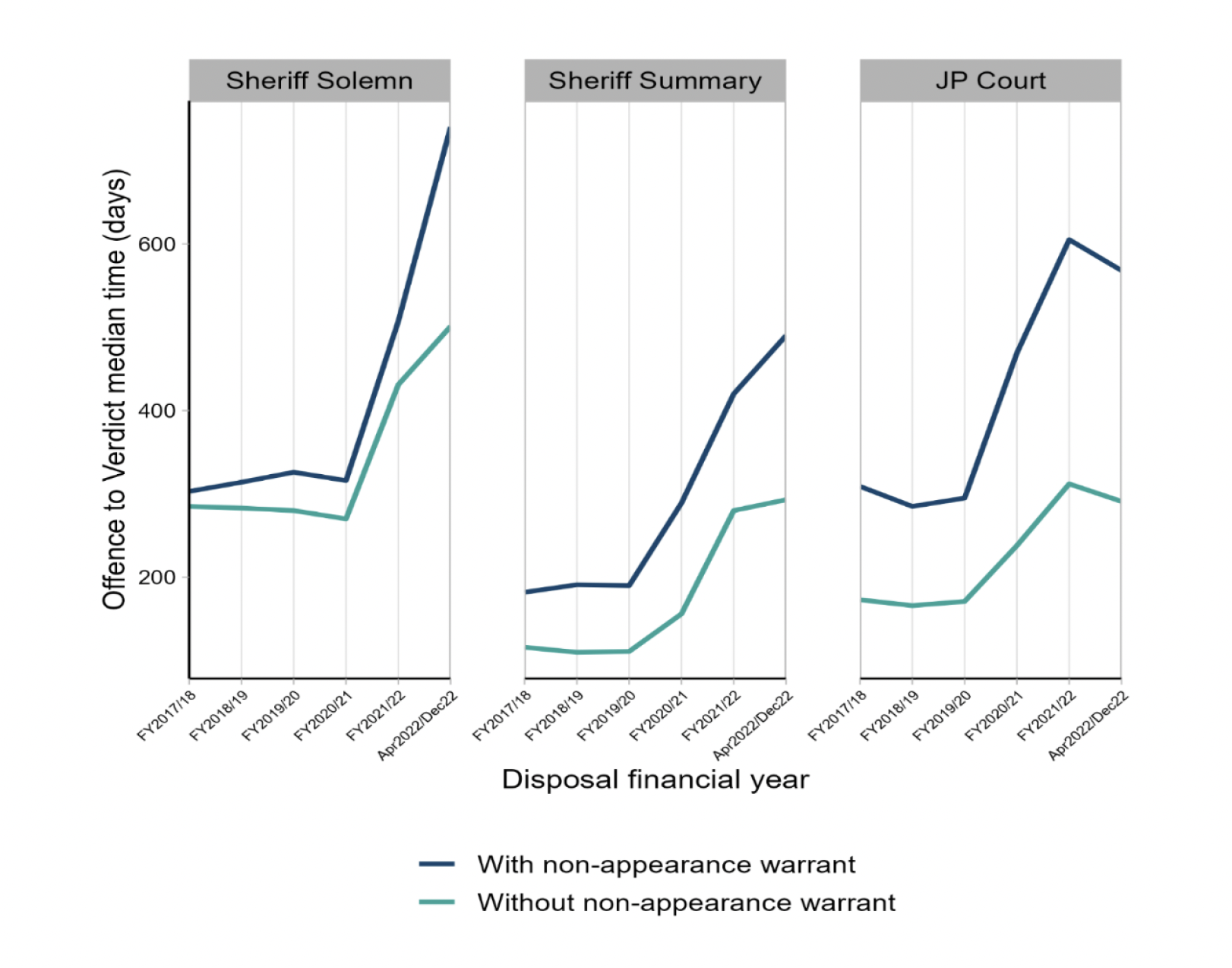
7.4. Time from offence to verdict by pre-court and in-court time
The available data allow us to split overall journey times into a pre court time (offence to court registration) and an in-court time (court registration to verdict) as shown in figure 6 (and supplementary table 4).
In all court types, median pre-court times increased post pandemic (from 2019-20 to 2021-22): from 333 days in 2019-20 to 493 days in the High court (+48%), from 225 to 252 days (+12%) in Sherriff solemn, from 24 days to 49 days in Sheriff summary (+104%) and from 122 days to 183 days in JP court (+50%).
In 3 court types (High Court and Sheriff Courts), these times have further increased over the 9 months of 2022-23 covered in the analysis. The High court saw a 129 day increase to 622 days (+26%), Sheriff solemn court saw a 39 day increase to 291 days (+15%) and Sheriff summary court saw a 16 day increase to 65 days (+33%). Pre court times in the JP court increased by 1 day to 184 days in the 9 months of 2022-23 covered in the analysis.
Median court registration to verdict time has also increased across all court types post-pandemic. The High Court saw median times increase from 151 days in 2019-20 to 390 days in 2021-22 (+158%), Sheriff solemn courts saw an increase from 52 days in 2019-20 to 110 days in 2021-22 (+112%), Sheriff summary times increased from 71 days to 176 days (+148%) and JP times increased from 34 days to 78 days (+129%).
In both the High court and the JP court, median in-court times have fallen over the 9 months of 2022-23 covered in the analysis by, 67 days to 323 days in High court (-17%) and by 14 days to 64 days in JP court (-18%). Sheriff solemn courts have seen a further increase in median times over the 9 months of 2022-23 covered in the analysis (by 15 days to 125 days, a 14% increase). Median in-court times for Sheriff summary court have increased by 4 days to 180 days (+2%).
Figure 6: Median time from offence to registration and registration to verdict by type of court.
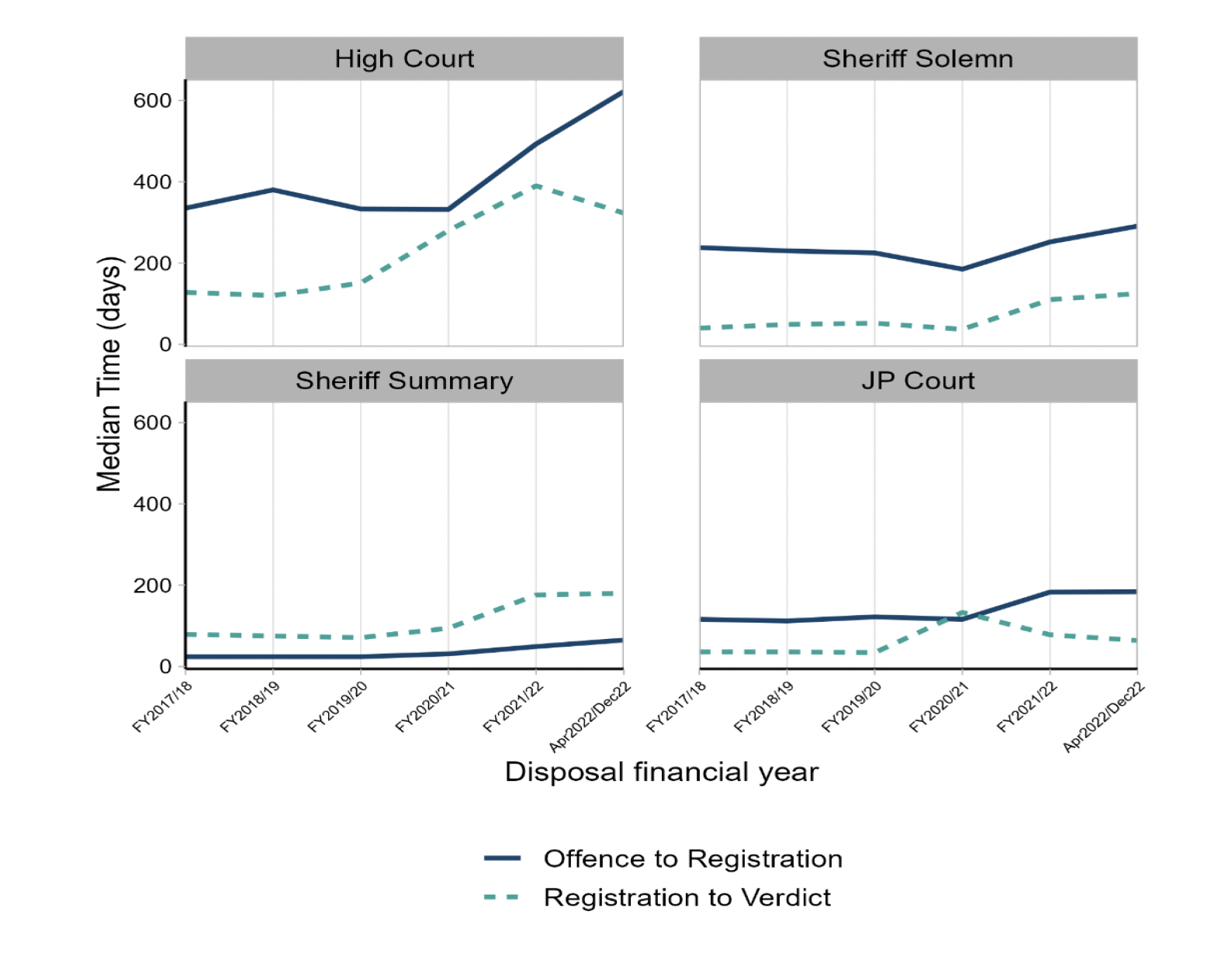
7.5. Time from offence to verdict by crime group
The types of crime committed by the accused affect the journey time. Analysis by crime group follows the methodology outlined in the methods section above.
7.5.1. Sexual crimes
Figure 7 (and supplementary table 5) shows offence to verdict, offence to registration and registration to verdict median times by court type for accused included in the sexual crimes group. Median journey times increased in all court types in 2021-22 when compared to 2019-20: from 1,544 to 1,963 days in High Court (+27%), from 562 to 704 days in Sheriff solemn court (+25%) and from 244 to 461 days in Sheriff summary court (+89%). However, over the 9 months of 2022-23 covered in the analysis, journey times have decreased in all court types except sheriff solemn. High court journey times have decreased by 459 days to 1,504 days (-23%) and Sheriff summary by 33 days to 428 days (-7%). Over the same period, journey times in Sheriff solemn have increased by 82 days to 786 days (+12%).
Comparing 2021-22 to 2019-20, offence to registration times for the sexual crimes group increased in High Court by 17% and Sheriff summary court by 14%. There was a small decrease in time in Sheriff solemn court (-2%). Registration to verdict times increased in all the courts: High court by 138%, Sheriff solemn by 65% and Sheriff summary by 118%.
The number of accused in JP court included in this group were too few to allow comparison.
Figure 7: Offence to verdict, offence to registration and registration to verdict median times by type of court for sexual crimes group accused.
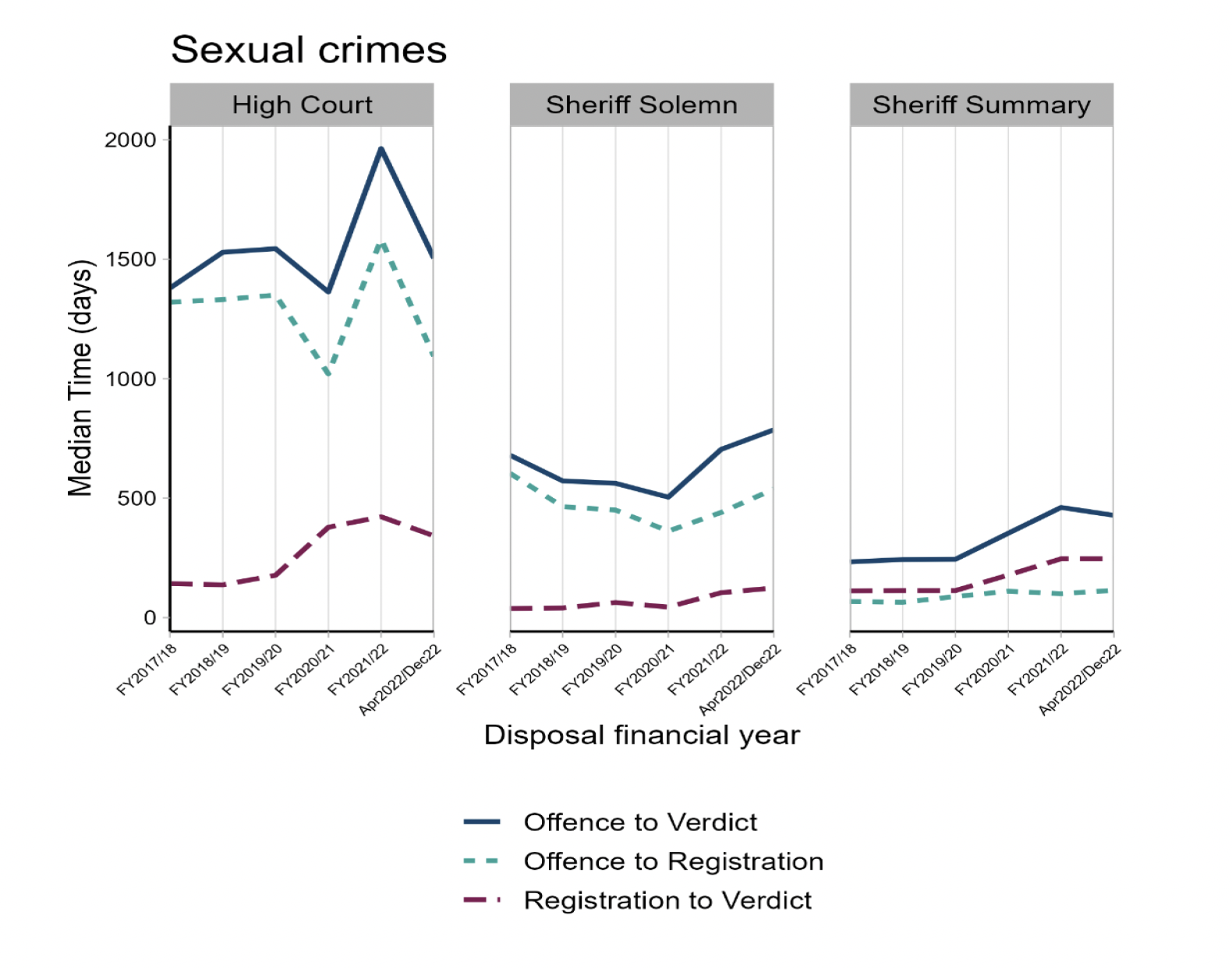
7.5.2. Non-sexual crimes of violence
The median times for accused in the non-sexual crimes of violence group are shown in figure 8 (and supplementary table 6). For this group median journey times have also increased in 2021-22 when compared to 2019-20: from 314 to 610 days in High court (+94%), from 265 to 405 days in Sheriff solemn court (+53%), from 143 to 349 days in Sheriff summary court (144%) and from 376 to 612 days in JP court (+63%).
Over the 9 months of 2022-23 covered in the analysis, journey times increased for all courts except for JP court: by 87 days to 697 days (+14%) in High Court, by 77 days to 482 days (+19%) in Sheriff solemn court and by 12 days to 361 days (+3%) in Sheriff summary court. Over the same 9 months of 2022-23, journey times in the JP court decreased by 42 days to 570 days (+7%).
Comparing 2021-22 to 2019-20, offence to registration times increased in High Court by 73%, in Sheriff solemn court by 21% and in Sheriff summary court by 112%; JP court decreased by 32%. Comparing 2021-22 to 2019-20, registration to verdict times increased in all court types: in High court by 153%, in Sheriff solemn court by 143%, in Sheriff summary court by 152% and in JP court by 217%.
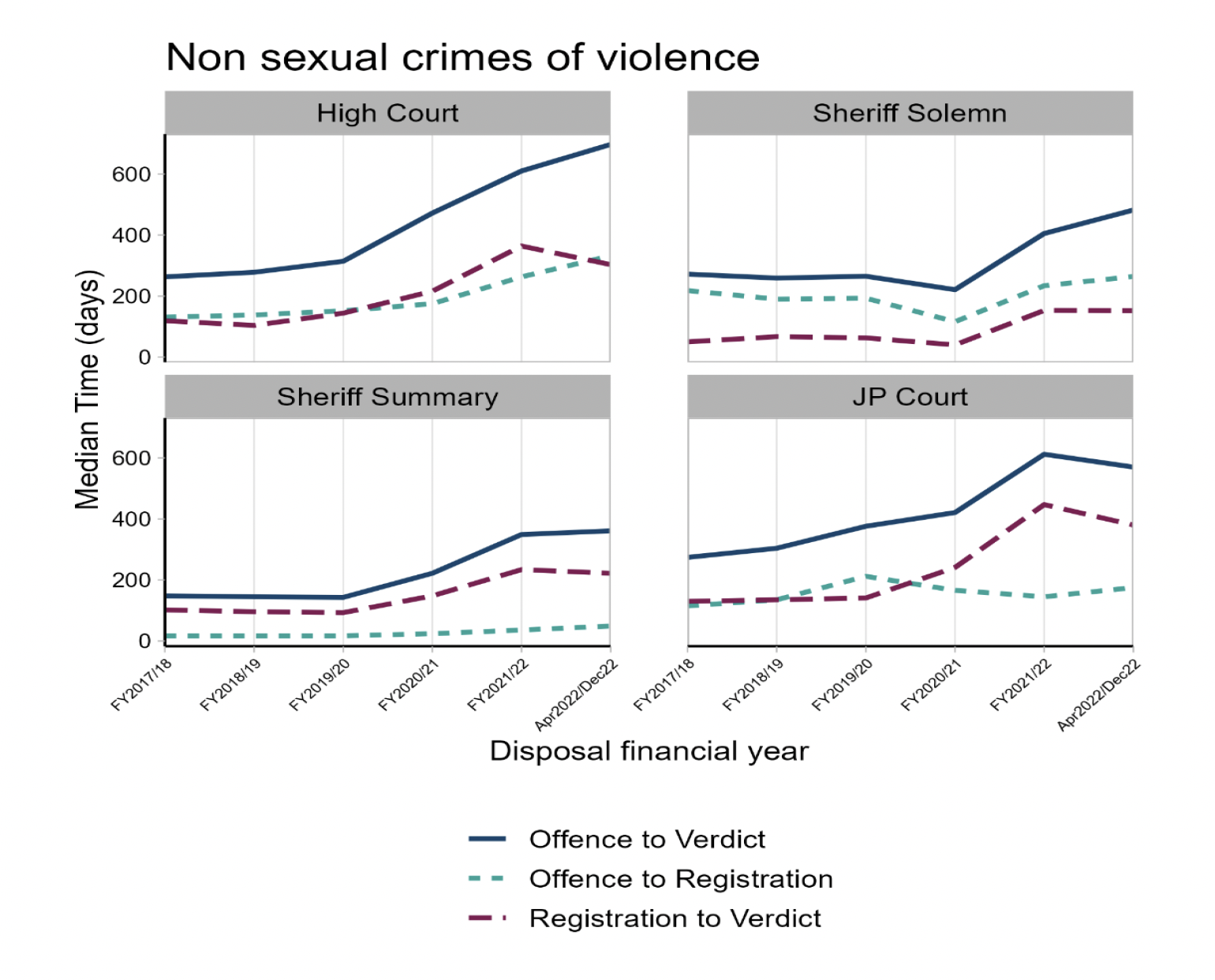
Common Assault is now included in the non-sexual crimes of violence group, having previously been part of the Miscellaneous offences group (see Annex 5: New crime grouping structure and next steps in the production of crime statistics - Recorded Crime in Scotland, 2021-2022 - gov.scot (www.gov.scot) for more detail). The volume of common assault cases is large, and many may be more straightforward and quicker to progress than other non-sexual crimes of violence cases involving for example murder or serious assault. To help overcome the possibility of many accused with common assault charges artificially lowering the median journey times for Group 1, Group 1 has been split into two sub-groups: 1 - accused with only common assault charges (and no other group 1 charges) and 2 - accused with at least one non-common assault Group 1 charge (accused in this group may also have a common assault charge). Times are presented for both subgroups and shown in figure 9 (and supplementary table 7).
In Sheriff solemn courts, journey times for accused with only common assault in 2021-22 were 218 days (-43%) shorter than journey times for other Group 1 accused. Similarly, in Sheriff summary courts, journey times for accused involving only common assault in 2021-22 were 150 days (-32%) shorter than journey times for other Group 1 accused. The number of accused involving only common assault in the High court are too few to allow comparison. Conversely, the number of accused with Group 1 charges other than common assault, in the JP court are also too few to allow comparison.
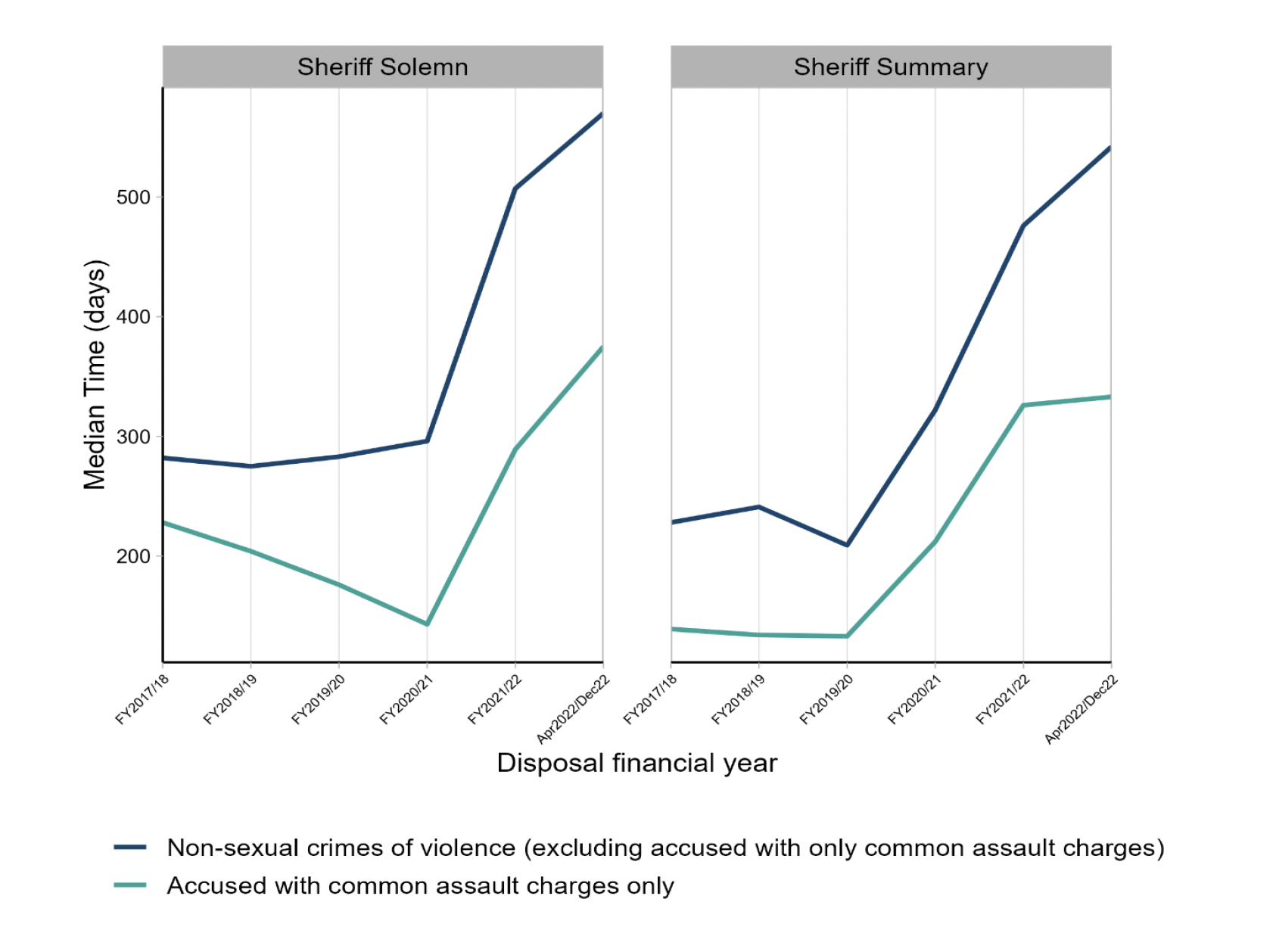
7.5.3. Crimes of dishonesty
Median offence to verdict journey times for crimes of dishonesty accused are shown in Figure 10 (and supplementary table 8). As with previous crime groups, journey times for cases included in the Crimes of dishonesty group increased in 2021-22 when compared to 2019-20: from 232 to 437 days in Sheriff solemn court (+88%), from 142 to 339 days in Sheriff summary court (+139%) and from 228 to 410 days in JP court (+80%). Over the 9 months of 2022-23 covered in the analysis, journey times increased in all court types apart from JP court. Times in Sheriff solemn court increased by 76 days to 513 days (+17%) and in Sheriff summary court by 22 days to 361 days (+6%). Over the same period, journey times in JP court decreased by 25 days to 385 days (-6%).
Comparing 2021-22 to 2019-20, offence to registration times increased in Sheriff solemn court by 38%, in Sheriff summary court by 51% and in JP court by 40%. Registration to verdict times also increased over this time period, by 112% in Sheriff solemn court, 275% in Sheriff summary court and 124% in JP court.
The number of accused in High court included in this group were too few to allow comparison.
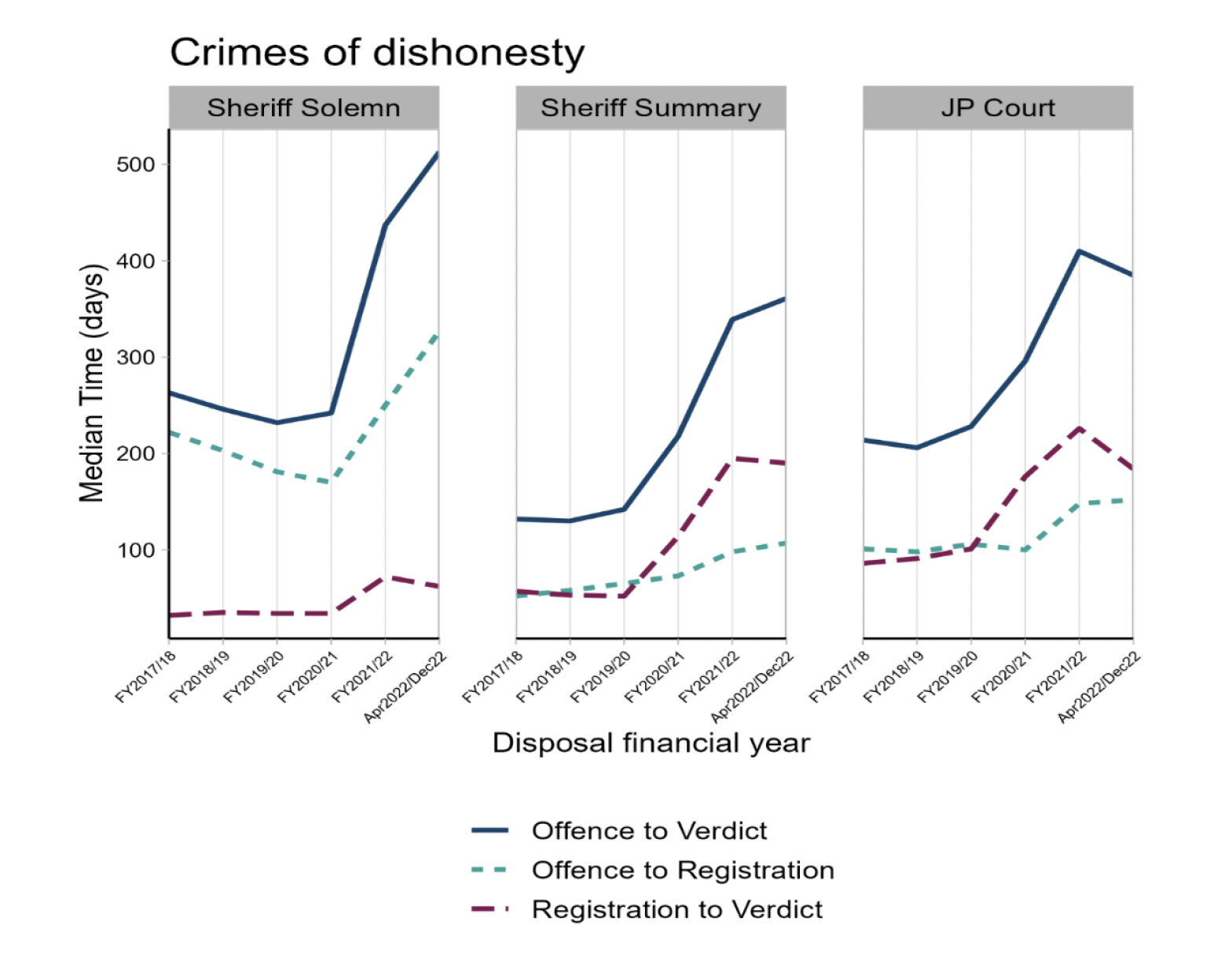
7.5.4. Damage and reckless behaviour
Median journey times for accused included in the damage and reckless behaviour group are shown in figure 11 (and supplementary table 9). For this group median journey times increased in 2021-22 when compared to 2019-20: from 304 to 407 days in Sheriff solemn court (+34%), from 110 to 278 days in Sheriff summary court (+153%) and from 253 to 490 days in JP court (+94%). Over the 9 months of 2022-23 covered in the analysis, journey times increased by 108 days to 515 days in Sheriff solemn court (+27%) and by 24 days to 302 days in Sheriff summary court (+9%). Over the same 9 months, journey times in the JP court decreased by 59 days to 431 days (-12%).
Offence to registration times also increased in 2021-22 when compared to 2019-20: by 1% in Sheriff solemn court, 192% in Sheriff summary court and 13% in JP court. Registration to verdict times also increased in all court types: by 59% Sheriff solemn court, by 151% in Sheriff summary court and by 217% in JP court.
The number of accused in High court included in this group were too few to allow comparison.
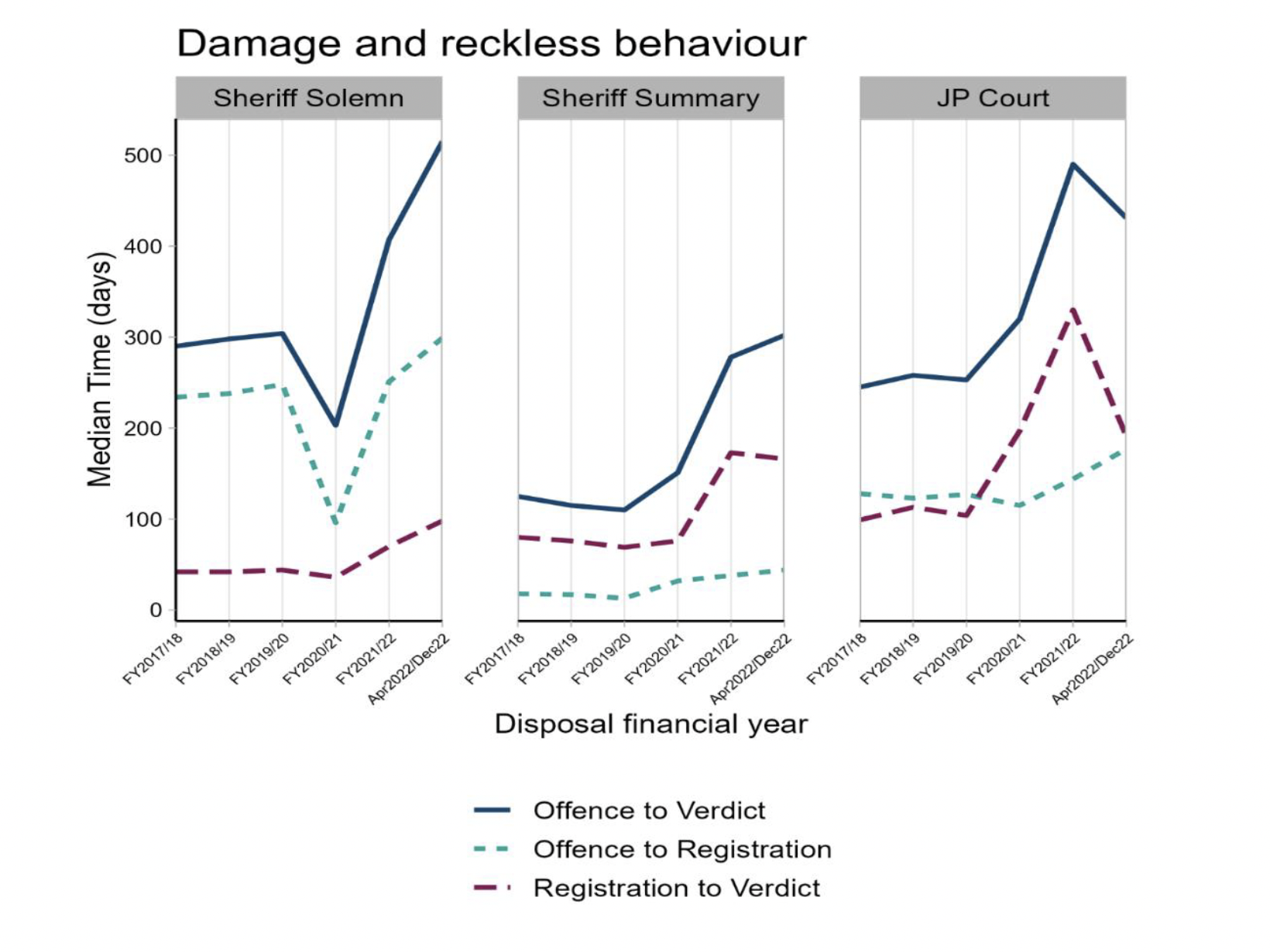
7.5.5. Crimes against society
Figure 12 (and supplementary table 10) shows the median journey times for accused in the crimes against society group. Median journey times increased in 2021-22 when compared to 2019-20: from 416 to 648 days in High Court (+56%), from 266 to 383 days in Sheriff solemn court (+44%), from 92 to 208 days in Sheriff summary court (+126%) and from 173 to 415 days in the JP court (+140%). Over the 9 months of 2022-23 covered in the analysis, journey times have increased for all court types except JP court. High court journey times increased by 278 days to 926 days (+43%), Sheriff solemn times increased by 98 days to 481 days (+26%) and Sheriff summary times increased by 32 days to 240 days (+15%). Over the same period, journey times in JP court decreased by 13 days to 402 days (-3%).
Offence to registration times also increased in 2021-22 when compared to 2019-20: by 36% in High Court, by 21% in Sheriff solemn court, by 33% in Sheriff summary court and by 148% in JP court. Registration to verdict times also increased in all court types: by 57% in High Court, by 42% in Sheriff solemn court, by 213% in Sheriff summary court and by 244% in JP Court.
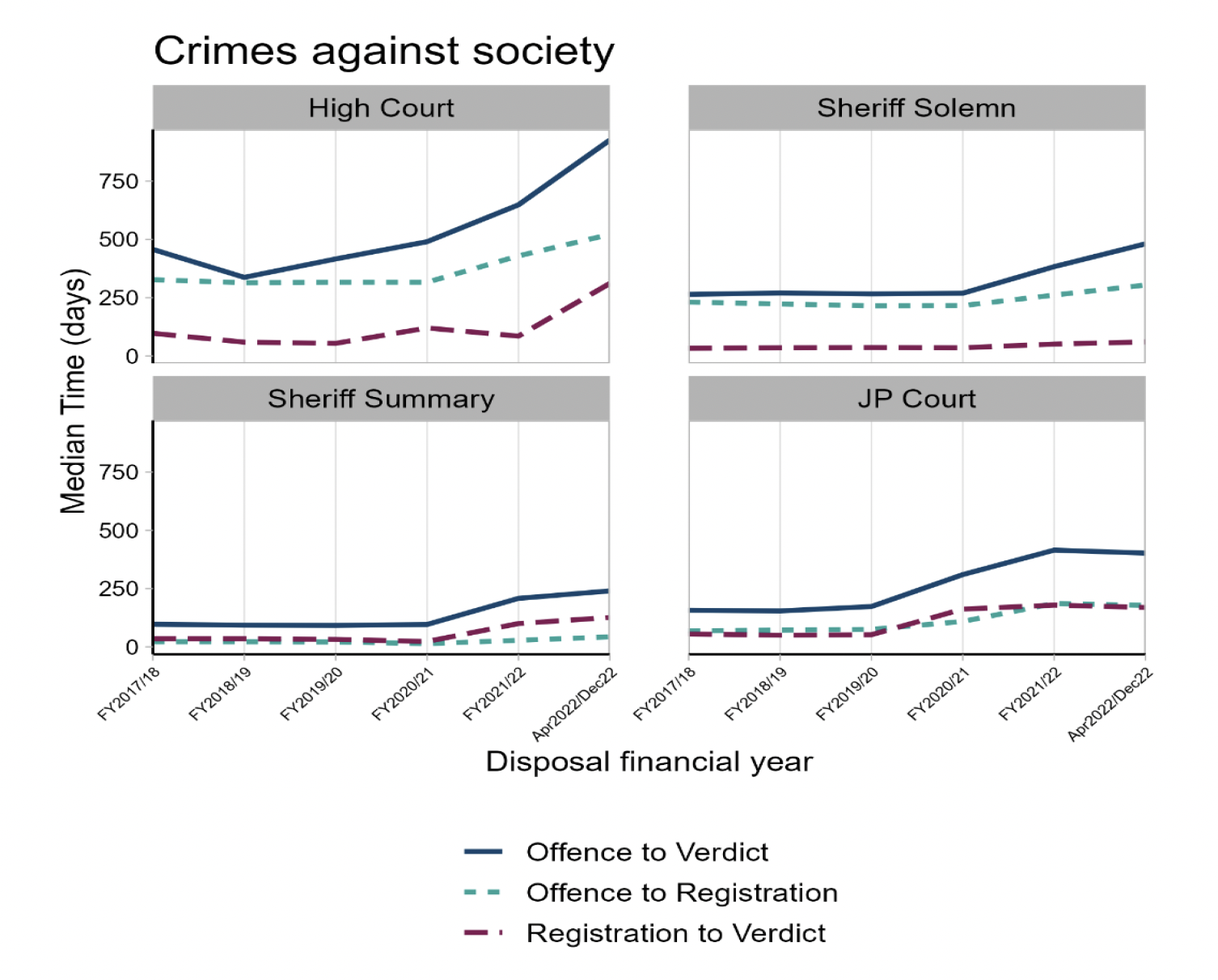
7.5.6. Antisocial offences
Journey times for accused included in the antisocial offences group are shown in figure 13 (and supplementary table 11). For this group median journey times increased in 2021-22 when compared to 2019-20: from 285 to 349 days in Sheriff solemn court (+22%), from 106 to 290 days in Sheriff summary court (+174%) and from 322 to 500 days in the JP court (+55%). Over the 9 months of 2022-23 covered in the analysis, Sheriff solemn journey times increased by 240 days to 589 days (+69%), Sheriff summary times increased by 35 days to 325 days (+12%) and JP court times increased by 42 days to 542 days (+8%).
Offence to registration times in Sheriff courts increased in 2021-22 when compared to 2019-20: by 20% in Sheriff solemn court and by 343% in Sheriff summary court. Offence to registration times decreased by 7% in JP court. Registration to verdict times increased in all court types: by 78% in Sheriff solemn court, and by 159% in Sheriff summary and JP courts.
The number of accused in High court included in this group were too few to allow comparison.
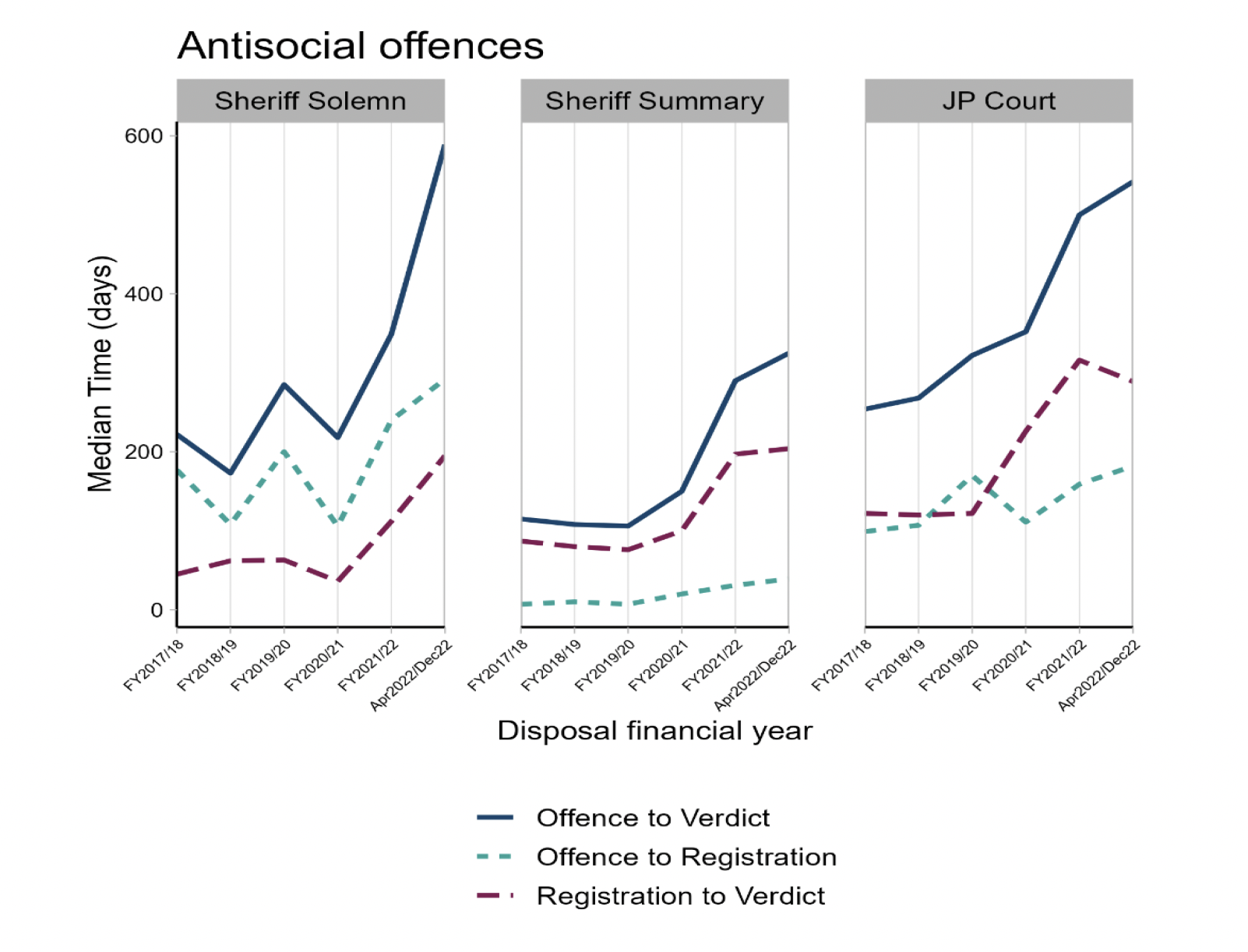
7.5.7. Miscellaneous offences
Journey times for accused in the miscellaneous offences group are shown in figure 14 (and supplementary table 12). Median journey times increased post pandemic in all court types: from 830 to 1,077 days in Sheriff solemn court (+30%), from 268 days to 384 days in Sheriff summary court (+43%) and from 222 days to 388 days in the JP court (+75%). In all court types, these times have further increased in the 9 months of 2022-23 covered in the analysis: by 147 days to 1,224 days in Sheriff solemn court (+14%), by 40 days to 424 days in Sheriff summary court (+10%) and by 100 days to 488 days in the JP court (+26%).
Comparing 2021-22 to 2019-20, offence to registration times increased in Sheriff solemn court by 13% and by 24% JP court. Offence to registration times decreased by 6% in Sheriff summary court. Registration to verdict times increased by 67% in Sheriff summary court and by 82% in JP Court but remained the same in Sheriff solemn court. However, median registration to verdict times in Sheriff solemn courts have increased by 591% in the first 9 months of 2022-23.
The number of accused in High court included in this group were too few to allow comparison.
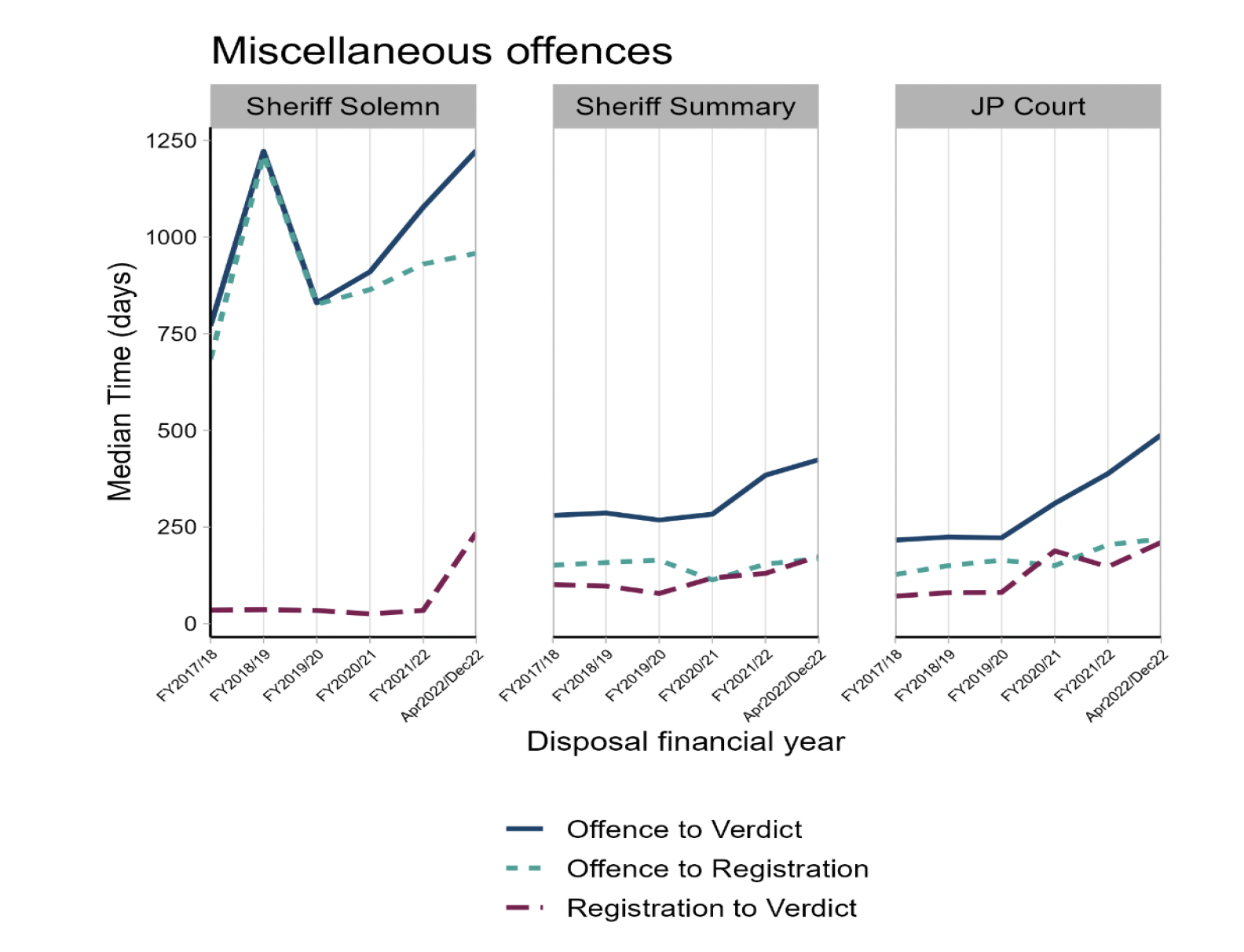
7.5.8. Road traffic offences
Journey times for road traffic offences are shown in figure 15 (and supplementary table 13). For this group median journey times increased in 2021-22 when compared to 2019-20: from 200 to 523 days in Sheriff solemn court (+162%), from 138 to 302 days in Sheriff summary court for (+119%) and from 171 to 303 days in JP court (+77%). Over the 9 months of 2022-23 covered in the analysis, journey times for this group decreased for all the courts except for Sheriff summary. Sheriff solemn decreased by 15% (-79 days) and JP court by 6% (-17 days). However, Sheriff summary journey times increased by 12% (+37 days).
Comparing 2021-22 to 2019-20, offence to registration times increased in all court types: by 121% in Sheriff solemn court, by 197% in Sheriff summary court and by 51% in JP court. Registration to verdict times also increased in all court types: by 132% in Sheriff solemn court, by 111% in Sheriff summary court and by 152% in JP Court.
The number of accused in High court included in this group were too few to allow comparison.
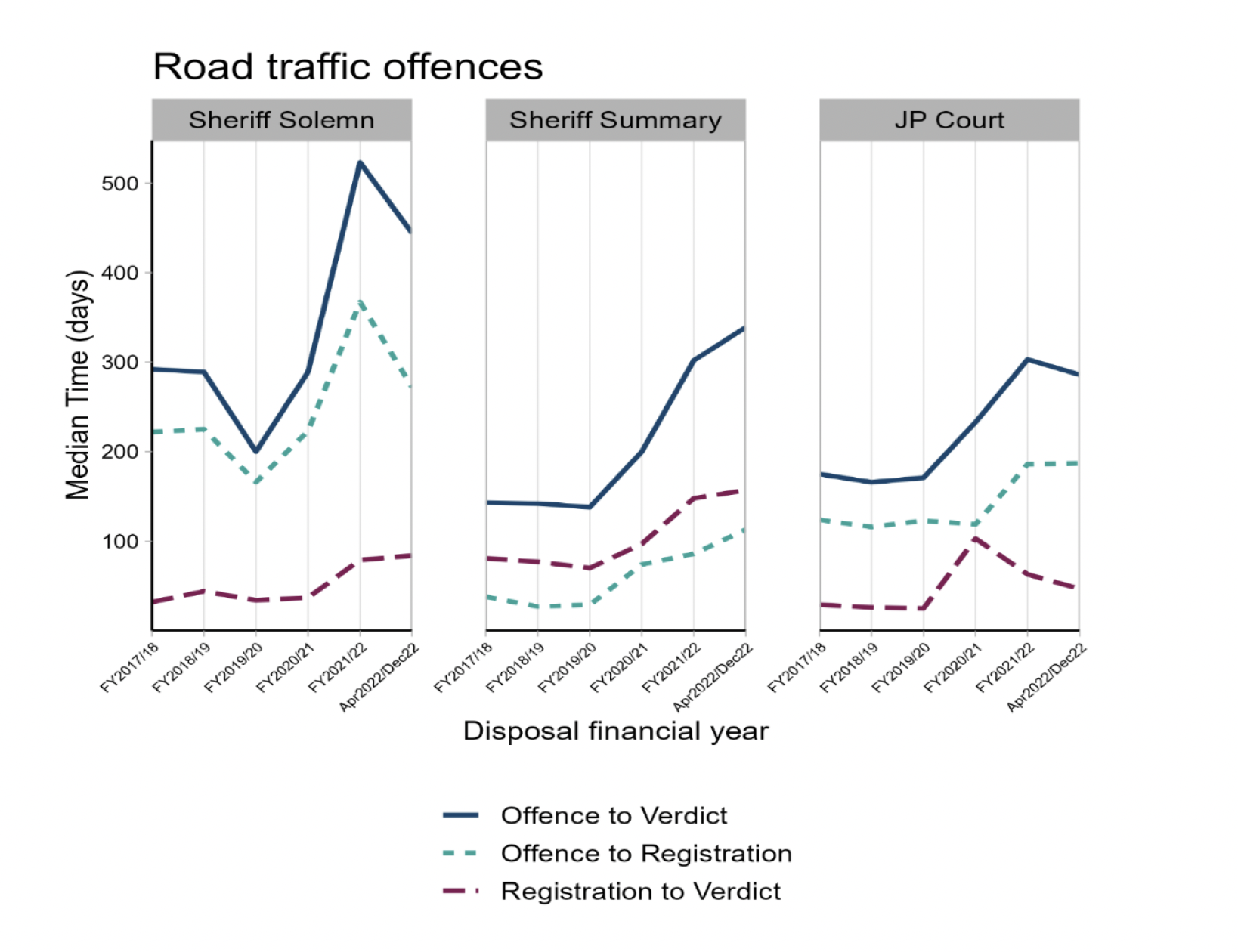
Contact
Email: justice_analysts@gov.scot
There is a problem
Thanks for your feedback